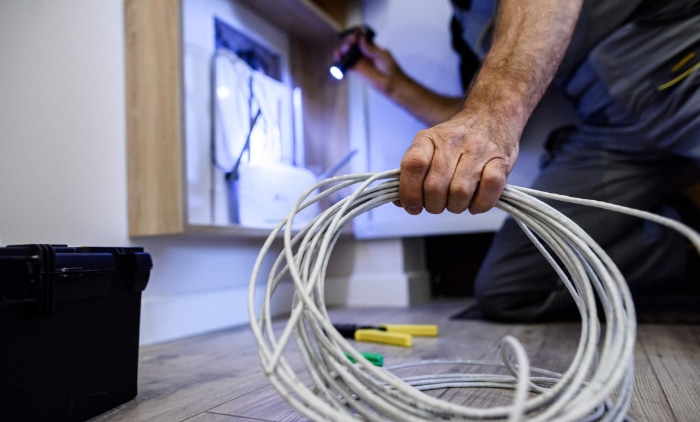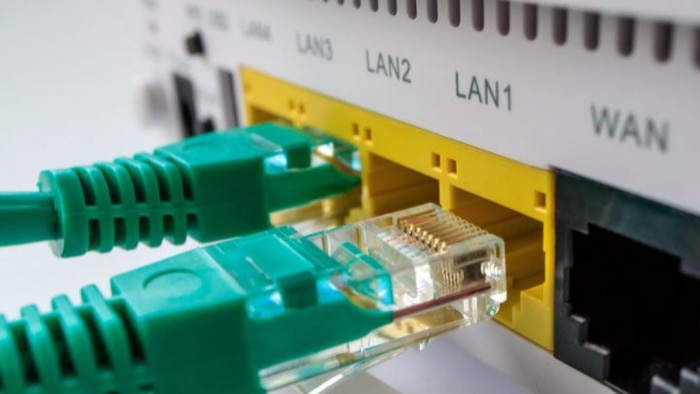How to Get Wired Internet in Another Room

Crafting a seamless, high-speed internet connection throughout your home isn’t just about boosting your streaming or gaming experience; it’s about harnessing the full potential of today’s digital era right at your fingertips. With the ever-growing demand for stable and reliable online access, the quest to extend a wired internet connection to another room has become a common yet crucial endeavor for many.
Assessing Your Needs
Before diving into the task of extending your wired internet to another room, it’s essential to evaluate your specific requirements and the physical layout of your home.
Determining Distance and Obstacles
The distance between your current router or modem and the new location plays a significant role in deciding the best approach. Shorter distances might be easily bridged with Ethernet cables, whereas longer distances might require more sophisticated solutions like powerline adapters or MoCA technology.
Additionally, consider the type of obstacles in your home, such as walls, floors, and large furniture, which could affect the signal strength and quality of your connection.
Estimating Internet Usage and Bandwidth Requirements
Reflect on how you plan to use the internet in the new location. Activities like streaming high-definition videos, online gaming, or large file transfers demand a higher bandwidth to maintain smooth performance.
If multiple devices will connect to the internet in this new space, ensure the solution you choose can handle the cumulative demand without compromising speed or stability.
Tools and Physical Layout
Familiarize yourself with the tools you might need for the installation process, such as drill machines for running cables through walls or Ethernet crimping tools. Also, consider the physical layout of your space.
Are there existing conduits or cable management systems you can leverage? Understanding these elements upfront can save time and effort during the installation phase.
Compatibility with Existing Infrastructure
Your current internet setup, including the type and age of your router or modem, can influence your choice of extension method. Some older devices may not support newer technologies like MoCA or may have a limited number of Ethernet ports.
Assessing the compatibility of your existing infrastructure with potential extension solutions ensures a smoother integration process.
Safety and Aesthetics
Lastly, think about how the installation might impact the safety and appearance of your home. Running cables along floorboards or through walls should be done in a way that doesn’t create tripping hazards or unsightly clutter.
Consider the aesthetic aspect of your solution, especially in common areas or spaces where the appearance is a priority.
Methods for Extending Wired Internet
Extending wired internet to another room requires a thoughtful approach, taking into account the specific needs and layout of your home. Several methods are available, each with its own set of advantages and considerations.
Running Ethernet Cables
One of the most straightforward methods to extend wired internet is by running Ethernet cables from your router to the new location. This solution provides a direct, reliable connection that’s ideal for high-bandwidth activities like gaming or streaming.
Steps Involved
- Measure the distance between the router and the new room to determine the length of the Ethernet cable needed.
- Choose a route that minimizes exposure and disruption to living spaces. Consider running cables along baseboards, through walls, or ceilings.
- Secure the cable along the chosen path using clips or cable management tools to keep it in place and out of sight.
Considerations
- Long cable runs may require professional installation to navigate through walls safely.
- High-quality, shielded Ethernet cables are recommended to prevent signal degradation over long distances.
Powerline Networking Adapters
Powerline adapters use the existing electrical wiring in your home to transmit internet signals. This method is effective for homes where running direct Ethernet cables is not feasible.
How It Works
- Plug one adapter into an outlet near your router and connect it with an Ethernet cable.
- Plug the second adapter into an outlet in the room where you need internet access.
- Connect your device to this second adapter using another Ethernet cable.
Pros and Cons
- Pros: Easy to set up and doesn’t require drilling or running cables through the house.
- Cons: Speed and reliability can be affected by the quality and layout of your home’s electrical wiring.
MoCA Adapters
Multimedia over Coax Alliance (MoCA) technology uses the coaxial cables already laid out for cable TV. It’s a great option if you have coaxial outlets in both rooms.
Setting Up
- Connect a MoCA adapter to your router and to the coaxial outlet in the same room.
- In the other room, connect a second MoCA adapter between the coaxial outlet and your device.
- Configure the adapters if necessary, following the manufacturer’s instructions.
Key Points
- MoCA supports high-speed internet connections, making it suitable for HD video streaming and online gaming.
- It’s more reliable and less prone to interference than powerline adapters.
Using a Mesh Network with Wired Backhaul
Mesh networks are typically known for expanding wireless coverage, but many mesh systems also support wired backhaul. This setup involves connecting the satellite units of the mesh network to the main router using Ethernet cables.
Implementation
- Place mesh network units in strategic locations throughout your home to ensure optimal coverage.
- Connect these units with Ethernet cables running back to the router.
- Configure the network according to the manufacturer’s instructions to enable wired backhaul.
Benefits
- Provides both robust wired and wireless internet connections.
- Scalable and flexible, allowing for easy expansion of your network.
Choosing the right method to extend your wired internet depends on a variety of factors, including your home’s layout, the distance between rooms, and the type of internet activities you prioritize. Each method offers a unique blend of ease of installation, performance, and reliability.
Tools and Equipment Needed

Preparing to extend your wired internet connection into another room involves gathering the right tools and equipment. Having everything you need before you start can streamline the process, making the installation smoother and more efficient.
For Running Ethernet Cables
Ethernet Cables
Select the appropriate length and category of Ethernet cable (e.g., Cat6 or Cat7) for your needs. The category affects the speed and bandwidth of the connection.
Cable Clips or Tacks
These help secure the cable along your chosen path, keeping it neat and preventing tripping hazards.
Drill and Drill Bits
If you’re planning to run cables through walls, a drill and the right size drill bits are necessary to create pass-through holes.
Fish Tape
Useful for pulling cable through walls, ceilings, or tight spaces, fish tape can make the job much easier, especially for longer runs.
For Powerline Networking Adapters
Powerline Networking Kit
The kit typically includes two adapters. Make sure the kit you choose supports the speed and performance requirements of your network.
Short Ethernet Cables
These are used to connect the adapters to your router and the device in the other room. Kits often include these, but check to make sure.
For MoCA Adapters
MoCA Adapters
You’ll need at least two adapters to set up a MoCA network. Ensure your adapters are compatible with the version of MoCA technology you plan to use.
Coaxial Cables
These are used to connect the MoCA adapters to the coaxial outlets in your home. You might need additional cables depending on your setup.
For Mesh Network with Wired Backhaul
Mesh Network System
Select a system that supports wired backhaul for the best performance. Consider the size of your home and the total coverage needed when choosing.
Ethernet Cables
You’ll need enough Ethernet cables to connect the main router to the satellite units of the mesh network, as well as to any devices that will use a wired connection.
General Tools
Cable Tester
A cable tester is invaluable for ensuring that your Ethernet cables are functioning correctly after installation.
Screwdriver Set
A variety of screwdrivers may be needed for installing wall plates or making adjustments to equipment.
Wire Strippers and Crimping Tool
If you’re making your own Ethernet cables, wire strippers and a crimping tool are necessary to attach the connectors properly.
Professional Installation Options
While DIY methods for extending wired internet to another room offer flexibility and a sense of accomplishment, professional installation can be a stress-free and efficient alternative, especially for complex setups. This approach ensures that the job is done correctly, potentially saving time and avoiding damage.
Internet Service Provider (ISP) Solutions
Many ISPs offer installation services for extending your network. This option ensures compatibility with your existing service and often comes with the benefit of support and guarantees.
- Expertise: Technicians are familiar with the network and can offer optimized solutions.
- Convenience: Setting up an appointment can be straightforward, often through your ISP’s customer service.
- Cost: Prices vary, but getting a quote ahead of time can help manage your budget.
Independent Contractors
Hiring an independent contractor or a company specializing in home networking can provide a customized solution tailored to your specific needs.
- Customization: They can offer more personalized solutions that cater to your home’s layout and your specific requirements.
- Flexibility: Independent professionals may have broader availability than ISP technicians.
- Considerations: Ensure the contractor is reputable and has experience with home networking projects.
Specialty Electronics and Home Automation Companies
For those looking for advanced solutions, such as integrating the wired network with a smart home system, specialty companies can provide comprehensive services.
- Integration: These companies can design a system that integrates seamlessly with your home automation and entertainment setups.
- Advanced Solutions: They can offer cutting-edge technology options that might not be available through ISPs or general contractors.
- Investment: While potentially more costly, the value comes from a customized, future-proofed home network.
Evaluating Your Options
When considering professional installation, assess the complexity of your project, your budget, and the level of customization you desire. It’s important to get quotes from multiple sources and check reviews or ask for references to ensure you’re choosing a reliable service provider.
Conclusion
Extending wired internet to another room enriches your digital lifestyle, merging convenience with the high-speed, stable connectivity essential for today’s online demands. Initiating this project begins with a clear evaluation of your specific requirements, followed by choosing a suitable method for extension, such as deploying Ethernet cables, leveraging powerline networking, utilizing MoCA technology, or integrating a mesh network with a wired backhaul.
Each option presents a unique set of advantages tailored to different needs and home layouts.
Opting for a DIY installation empowers you with direct control over the process, potentially offering a satisfying sense of accomplishment once completed. On the other hand, professional installation services provide expertise and efficiency, especially beneficial for complex setups or when time is of the essence.
This journey of enhancing your home’s internet infrastructure not only boosts your connectivity in new spaces but also opens up possibilities for improved entertainment, work, and study experiences. With careful planning and execution, the extension of wired internet becomes a valuable upgrade to your home, ensuring you stay well-connected in our increasingly digital world.


